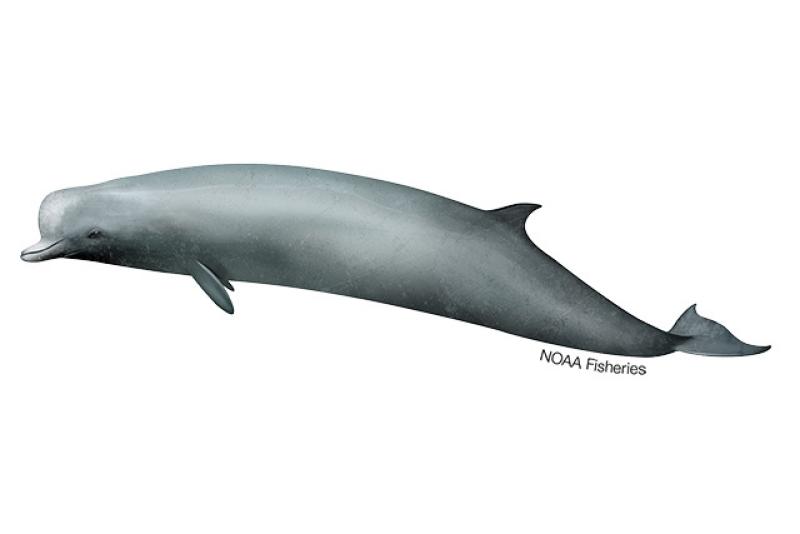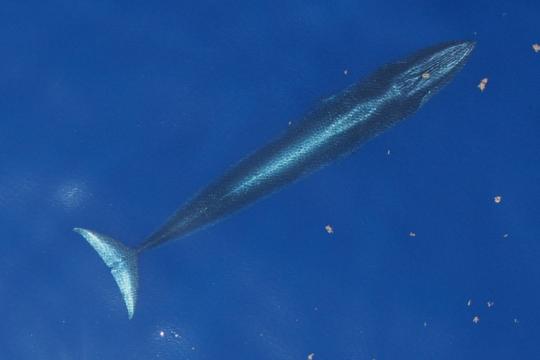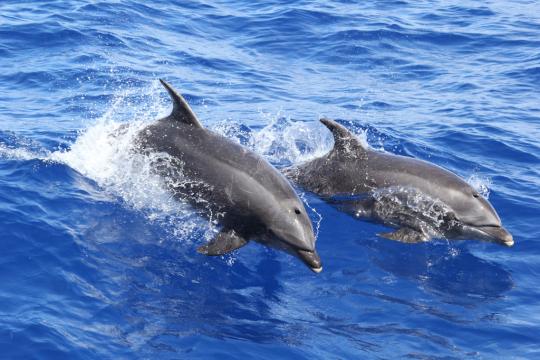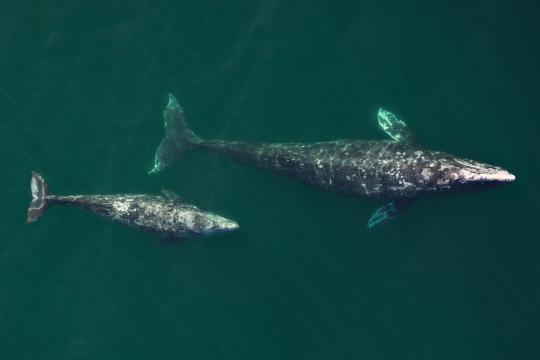Northern Bottlenose Whale
Hyperoodon ampullatus

Protected Status
Quick Facts
 A pod of northern bottlenose whales surfacing in the Atlantic Ocean near Pico Island, Azores. Credit: Shutterstock.com
A pod of northern bottlenose whales surfacing in the Atlantic Ocean near Pico Island, Azores. Credit: Shutterstock.com
A pod of northern bottlenose whales surfacing in the Atlantic Ocean near Pico Island, Azores. Credit: Shutterstock.com
About the Species
 A pod of northern bottlenose whales surfacing in the Atlantic Ocean near Pico Island, Azores. Credit: Shutterstock.com
A pod of northern bottlenose whales surfacing in the Atlantic Ocean near Pico Island, Azores. Credit: Shutterstock.com
A pod of northern bottlenose whales surfacing in the Atlantic Ocean near Pico Island, Azores. Credit: Shutterstock.com
Northern bottlenose whales are the largest members of the beaked whale family in the North Atlantic Ocean, where they prefer cold, deep, temperate to sub-arctic oceanic waters. Their scientific name (Hyperoodon ampullatus) is derived from the Latin word ampulla for the bottle shape of their beak.
Overall, the beaked whale family is cryptic and skittish, making it difficult to distinguish between them. Northern bottlenose whales, however, are the most extensively studied of the beaked whales because they used to be heavily hunted, making carcasses available for scientists to examine.
Although they were easy targets for whalers long ago and currently face threats from human-caused noise, northern bottlenose whales in the United States are not endangered or threatened. Like all marine mammals, they are protected under the Marine Mammal Protection Act.
Population Status
NOAA Fisheries estimates population size for northern bottlenose whales in its stock assessment reports. A stock is a group of animals that occupy the same area and interbreed. There is little information on the abundance of this species worldwide, and data are insufficient to estimate population trends.
Appearance
As adults, northern bottlenose whales can reach lengths of approximately 36.7 feet and weigh up to 16,534 pounds. Males may be slightly larger than females. Northern bottlenose whales have a large, long, robust body with a small, triangular, hooked dorsal fin that is located about two-thirds down their back. They have a distinctive, bulbous forehead (known as a melon) that is lighter in color and a well-defined, bottle-shaped beak; however, these characteristics may vary with sex and age. The melon becomes steeper and flatter as the whale ages. Adult males have a pair of relatively small, conical teeth that angle slightly forward and are visible on the tip of the lower jaw. A second pair of teeth is sometimes hidden in the gums behind the exposed pair of teeth, and 10 to 20 additional vestigial teeth can be found in the gums of the upper and lower jaw.
While at the ocean surface, northern bottlenose whales produce fairly small, bushy blows every 30 to 40 seconds that are about 3.3 feet tall and visible from a significant distance. Their coloration varies from dark gray to brownish to olive, and their skin may appear lightly mottled and covered with scars and/or other markings. The dorsal side is darker than the ventral side, giving it a counter-shading appearance. The face and melon often appear light gray to white. Mature females often have a white band around the neck.
Behavior and Diet
Northern bottlenose whales are usually found individually or in social groups averaging between four and ten individuals, but they have been occasionally seen in larger groups and loose aggregations of up to 50 animals. Groups may consist of various combinations and/or be segregated depending on age, sex, or life stage. Males are known to be combative, using their large heads to hit one another. This species does not tooth rake during aggressive encounters, unlike other species of beaked whales.
Regular dives of northern bottlenose whales range from less than 10 minutes to 60 minutes, commonly reaching depths of at least 2,600 to 5,000 feet, but they are likely capable of diving and holding their breath for up to two hours. While diving, they feed near the ocean bottom mostly on deep-sea cephalopods (e.g., squid), fish (e.g., herring), shrimp, sea cucumbers, and sea stars. Juvenile animals may feed on prey closer to the surface.
Where They Live
Northern bottlenose whales prefer cold, deep, temperate to sub-arctic oceanic waters usually greater than 6,500 feet. They are often associated with steep underwater geologic structures such as submarine canyons, seamounts, and continental slopes.
Northern bottlenose whales can be found throughout the North Atlantic Ocean and range from New England, Canada, Greenland, Iceland, England, and Europe up to Spitzbergen and down to the Azores and northern Africa (Canary Islands). They have been sighted from 30 degrees North to close to the ice edge in the Arctic. Scientists have conducted long-term studies of a resident group off of Nova Scotia, Canada (a large submarine canyon called the “Gully”), and strandings have occurred in the Baltic Sea, Bay of Fundy, and Rhode Island. This species can travel more than 620 miles.
Lifespan & Reproduction
Northern bottlenose whales reach sexual maturity between seven and 11 years. A sexually mature female will give birth to a single calf every two or more years during the spring or summer (usually between the months of April and August). Gestation lasts about 12 months. Newborn calves are about 10 to 11.5 feet in length and weigh 660 pounds. These whales have an estimated lifespan of at least 37 years.
Threats
Hunting
Fishermen discovered spermaceti (a waxy substance used in oil lamps, lubricants, and candles) in Northern bottlenose whales in the 1850s, which started a commercial whaling fishery for the species. The species was also hunted for pet food. Whalers exploited the curiosity and social bonds of these animals, which were often attracted to stationary vessels and stayed with wounded or injured members of their pod. The fishery closed in the 1970s. During this time, whalers killed more than 80,000 Northern bottlenose whales.
For the last several decades, northern bottlenose whales have remained unexploited, except for the animals killed in the Faroe Islands drive fishery. In Canada and Norway, these whales were hunted for meat and oil until the population was depleted.
Ocean Noise
This species may be sensitive to underwater sounds and man-made noise. Deep-diving cetaceans like northern bottlenose whales use sound to feed, communicate, and navigate in the ocean. Sound pollution threatens them by interrupting their normal behavior and driving them away from areas important to their survival.
Scientific Classification
| Kingdom | Animalia | Phylum | Chordata | Class | Mammalia | Order | Cetacea | Family | Ziphiidae | Genus | Hyperoodon | Species | ampullatus |
|---|
Last updated by NOAA Fisheries on 11/27/2024
What We Do
Conservation & Management
All northern bottlenose whales are protected under the Marine Mammal Protection Act. Our work protects this species by:
- Reducing interactions with commercial and recreational fishing gear
- Implementing requirements to reduce serious injuries and mortalities
- Minimizing the effects of vessel disturbance, noise, and other types of human impacts
- Educating the public about the threats beaked whales face
Science
Our research projects have helped us better understand northern bottlenose whales and the challenges they face. Our work includes:
- Stock assessments
- Acoustic monitoring
- Satellite tagging and tracking
- Shipboard surveys
How You Can Help
Keep Your Distance
Be responsible when viewing marine life in the wild. Observe all small whales from a safe distance of at least 100 yards and limit your time spent observing to 30 minutes or less.
Report Marine Life in Distress
Report a sick, injured, entangled, stranded, or dead animal to make sure professional responders and scientists know about it and can take appropriate action. Numerous organizations around the country are trained and ready to respond. Never approach or try to save an injured or entangled animal yourself—it can be dangerous to both the animal and you.
Learn who you should contact when you encounter a stranded or injured marine animal
Report a Violation
Call the NOAA Fisheries Enforcement Hotline at (800) 853-1964 to report a federal marine resource violation. This hotline is available 24 hours a day, 7 days a week for anyone in the United States.
You may also contact your closest NOAA Office of Law Enforcement field office during regular business hours.
Featured News

 A Rice’s whale just under the surface of the water in the Gulf of Mexico. This endangered whale was recognized as a separate species from the Bryde’s whale in 2021. Credit: NOAA Fisheries under NOAA Permit No. 21938.
A Rice’s whale just under the surface of the water in the Gulf of Mexico. This endangered whale was recognized as a separate species from the Bryde’s whale in 2021. Credit: NOAA Fisheries under NOAA Permit No. 21938.
Celebrate Whale Week with Us: A Message from Janet Coit, Assistant Administrator of NOAA Fisheries
 Pair of bottlenose dolphins. Credit: NOAA Pacific Islands Fisheries Science Center/Lisa Morse.
Pair of bottlenose dolphins. Credit: NOAA Pacific Islands Fisheries Science Center/Lisa Morse.
 Gray whales were nearly hunted to extinction by commercial whaling. Protections under the MMPA, ESA, and the end of commercial whaling have allowed the species to recover. Credit: NOAA Fisheries (Permit #19091).
Gray whales were nearly hunted to extinction by commercial whaling. Protections under the MMPA, ESA, and the end of commercial whaling have allowed the species to recover. Credit: NOAA Fisheries (Permit #19091).
Celebrating 50 Years of the Marine Mammal Protection Act
Management Overview
The northern bottlenose whale is protected throughout its range under the Marine Mammal Protection Act.
Additionally, the northern bottlenose whale is listed under:
- Appendix I of the Convention on International Trade in Endangered Species of Wild Fauna and Flora (CITES)
Conservation Efforts
Overseeing Marine Mammal Health and Stranding Response
We work with volunteer networks in all coastal states to respond to marine mammal strandings including all whales. When stranded animals are found alive, NOAA Fisheries and our partners assess the animal’s health and determine the best course of action. When stranded animals are found dead, our scientists work to understand and investigate the cause of death. Although the cause often remains unknown, scientists can sometimes attribute strandings to disease, harmful algal blooms, vessel strikes, fishing gear entanglements, pollution exposure, and underwater noise. Some strandings can serve as indicators of ocean health, giving insight into larger environmental issues that may also have implications for human health and welfare.
Learn more about the Marine Mammal Health and Stranding Response Program

Marine Mammal Unusual Mortality Events
Northern bottlenose whales have never been part of a declared unusual mortality event. Under the Marine Mammal Protection Act, an unusual mortality event is defined as "a stranding that is unexpected; involves a significant die-off of any marine mammal population; and demands immediate response." To understand the health of marine mammal populations, scientists study unusual mortality events.
Get information on active and past UMEs
Get an overview of marine mammal UMEs
Addressing Ocean Noise
NOAA Fisheries is investigating all aspects of acoustic communication and hearing in marine animals, as well as the effects of sound on beaked whale behavior and hearing. In 2016, we issued technical guidance for assessing the effects of anthropogenic sound on marine mammal hearing.
Regulatory History
Northern bottlenose whales are protected under the Marine Mammal Protection Act.
Key Actions and Documents
Last updated by NOAA Fisheries on 11/27/2024
Science Overview
Stock Assessments
Determining the population size of the northern bottlenose whales helps resource managers gauge the success of NOAA Fisheries’ conservation measures. Our scientists collect and present these data in annual stock assessment reports.

Shipboard Studies
NOAA Fisheries conducts research cruises to collect information on beaked whale stocks, such as habit preferences and feeding ecology. These studies also help us estimate the abundance of beaked whales. Information from this research can be used in management actions to protect these animals.
Acoustic Science
Our research is also focused on acoustics—the physics of the properties of sound. We study the basic acoustic behavior of cetaceans and fish, mapping the acoustic environment and finding better ways to find cetaceans using acoustic technologies. Our acoustic research also assesses the degree to which human-caused activities are changing the underwater soundscape, how these changes may potentially impact marine animals in their acoustic habitat, and what measures can be taken to mitigate these potential impacts.
More Information
Last updated by NOAA Fisheries on 11/27/2024